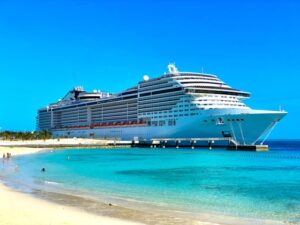
Exploring multiple countries on a cruise ship is one of the greatest adventures one could ever have. You wake up somewhere new every day and have more to look forward to as the week goes by.
It’s the dream vacation for many, and also a flexible lifestyle fit for professionals from all walks of life. Whether you’re a travel creator, a remote worker, a 9-to-5er on leave, or even a financial market investor. There’s more than enough room for everyone on board.
However, while cruise ships may appear to provide everything a traveler could possibly need, one essential service often slips through the cracks. As travelers are disembarking the ship from one location to the other, they need reliable internet that can be activated on the go.
This article explores the opportunities cruise lines can capitalize on by establishing an eSIM kiosk for their passengers.
Why is Connectivity Essential for Cruise Passengers?
Most cruise ships tour several locations; for instance, a 19-night Mediterranean cruise departing from Barcelona could visit up to 6 ports, including locations like Barbados, Casablanca, Grenada, and others.
Staying connected has become a fundamental part of every traveler’s experience when exploring these destinations. This takes us to the first reason internet access is relevant for the cruise ship industry: navigation.
Finding yourself in a new location is exhilarating, but it can quickly turn into fear and panic without access to the internet, navigation systems, or the means to reach your destination. It’s also important to note that not all travelers are on vacation. Some cruises have remote workers, digital nomads, and others with varying professions that allow this sort of flexibility.
For individuals who fall in such a category, access to data connectivity is also non-negotiable, as they need internet access to connect, communicate, and work as they touch base in these countries.
The Current Connectivity Reality upon Disembarkment

Many cruise ships provide internet connections to the passengers on board. Some luxury cruise lines like Viking, Virgin Voyages, and Silversea also offer complimentary internet access while passengers are on board. However, what happens when they step out of the cruise lines at ports?
They face the challenges of finding working internet connections at kiosks and obtaining a new SIM. Most of the time, the available options are traditional physical SIM cards that take a long time to set up and are unnecessarily time-consuming.
Another challenge with traditional SIM cards in new locations is that users must purchase a local SIM in each new country. This includes other processes like finding a store, providing ID, and waiting in line for activation.
Having to repeat such tasks on several occasions isn’t something any traveler would sincerely look forward to. Imagine taking a Mediterranean cruise that plans to stop at six ports. At each port, you’d go through this same tedious process over and over again.
Another major problem is that while at sea, passengers have limited connectivity options and often have no choice but to rely on the expensive satellite internet services provided by the cruise line. However, once the ship gets closer to shore or within the range of a local port, most travelers quickly switch to local mobile networks to avoid high roaming or satellite charges, leading to a loss of potential revenue for the cruise operator.
Port authorities could solve most of these problems by setting up a kiosk for eSIM purchases in strategic locations where passengers disembark. The cruise line company could also place kiosks on board for passengers to purchase eSIMs before disembarking, with a white label eSIM store for management.
By partnering with Limitflex’s white-label, ready-to-use eSIM service, cruise lines can retain these customers under their own branded connectivity solution. This allows passengers to stay connected seamlessly, even when switching to local networks, while the cruise company maintains control of the user experience and data relationship.
How do eSIM Kiosks Come Into Play?

eSIMs, embedded SIM cards, are currently regarded as the best alternative to the traditional approach to connectivity. They are digital SIM cards and are built into the device instead of a physical card you have to insert.
Hence, users get to access internet connections without necessarily switching SIM cards or visiting a store at every port. Here are some advantages of eSIM kiosks for passengers and cruise lines:
- Physical SIM Card Challenge for Travelers: The primary advantage here is that travelers get to eliminate the repetitive task of visiting physical SIM stores at every stop. Instead of queuing at local telecom shops, visitors arriving at a port can walk up to a kiosk, set up their eSIM, scan a QR code, and activate a local or regional eSIM.
- Supporting Multi-Country Itineraries: Docking at multiple countries in days also gets easier, because it can be used to offer regional plans. For instance, travelers can buy an Europe-wide plan once to stay connected across these regions. So each time they stop in a new country, their internet is connected and they’re ready to go.
- Revenue opportunity for Cruise lines: Setting up an eSIM kiosk on board for travelers to buy eSIMs when they disembark can be an opportunity to increase revenue.
Utilizing Ports as New Retail Goldmines
The connectivity need at ports is a real challenge for travelers, and cruise lines wouldn’t only be solving this problem, they’ll also be opening a new opportunity to increase their revenues passively.
It’s a win-win situation for all. If you’re thinking of ways to get started, check out our white label eSIM retail service on LimitFlex. We’ll help you set up your branded eSIM platform, and you get a 30% commission on sales.






